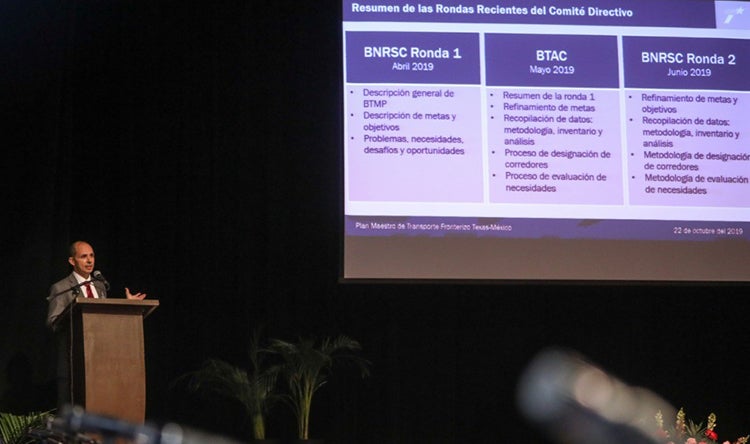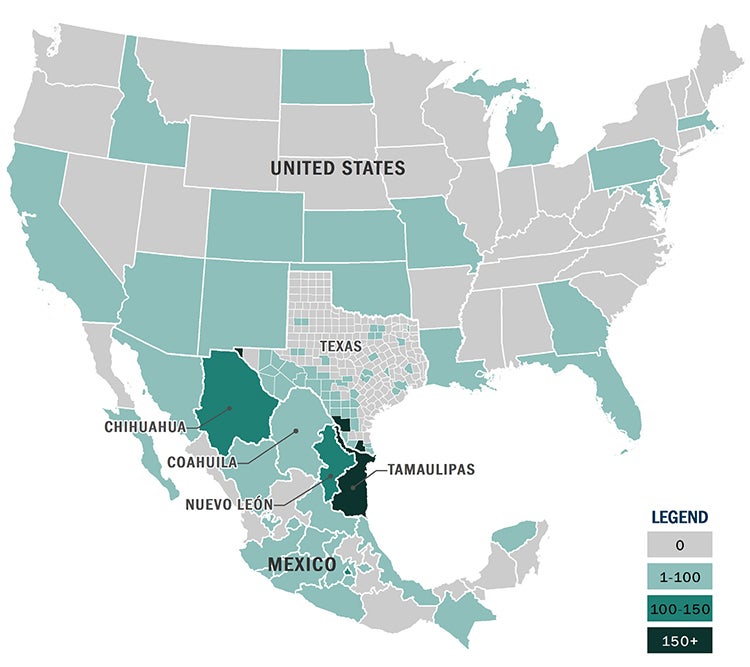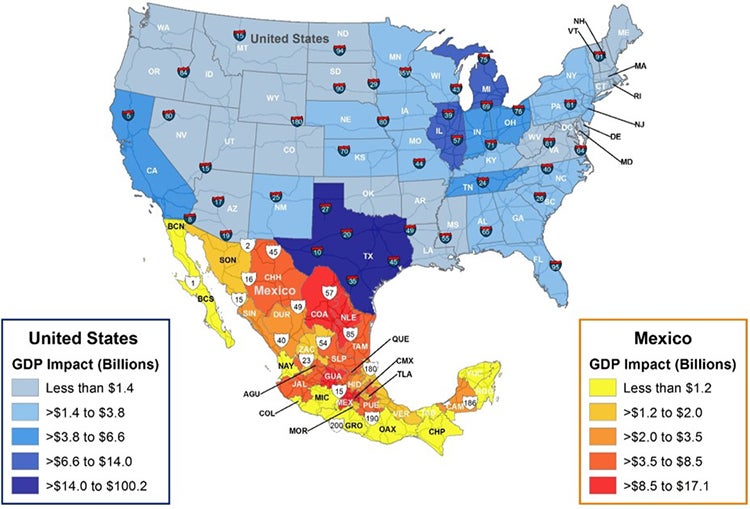Texas-Mexico Border Transportation Master Plan

Texas-Mexico Border Transportation Master Plan
A Binational Transportation Planning Initiative Involving Thousands of Stakeholders and Affecting Millions of Residents
The 1,254-mile Texas-Mexico border is North America’s busiest gateway for the movement of people and goods. Along its length, 28 vehicle border crossings as well as airports, seaports, rail lines, pipelines and other crossings connect more than 7 million residents and businesses in a vibrant, complex and growing border region. As of 2019, more than $24 million in trade crosses the Texas-Mexico border each hour, and the number continues to grow.
Hoping to improve cross-border mobility, trade and transportation in this diverse binational region, the Texas Department of Transportation selected HDR to help in the development of the Texas-Mexico Border Transportation Master Plan. This multiyear process was a collaborative and data-driven effort by TxDOT and its binational partners and stakeholders to identify the challenges and opportunities today and in the future for the Texas-Mexico border region and the strategies needed to address those challenges.
As the lead consultant on this unprecedented collaborative transportation planning effort, HDR led the public outreach, infrastructure assessment, forecast and economic analysis, identification of strategies and recommendations, and the drafting of the final report.
Stakeholder Coordination, Strategic Communications

The BTMP was unique in the breadth of its outreach. A proactive bilingual engagement process provided opportunities to gather feedback from people who live and work in the region, as well as from those impacted by the border from a regional, state and national perspective. More than 2,500 individuals from the U.S. and Mexico were involved in the stakeholder engagement process. They included existing binational advisory groups such as the Border Trade Advisory Committee, the U.S.-Mexico Joint Working Committee on Transportation Planning and the Binational Bridges and Border Crossings Group. Other stakeholders consulted included, but were not limited to:
- Industry: Class 1 railroads, manufacturing interests, trucking
- Local leadership: mayors, county judges, economic development councils
- State leadership: TxDOT; Texas Secretary of State; officials from Chihuahua, Coahuila, Nuevo Leon, Tamaulipas
- Federal leadership: Federal Highway Administration, Customs and Border Protection, Federal Motor Carrier Safety Administration, U.S. Department of Homeland Security, Mexican ambassador to U.S., Mexico’s Department of Transportation ( Secretaría de Comunicaciones y Transportes ), Mexican Customs (Aduanas) and Mexican Toll Road Authority (Caminos y Puentes Federales de Ingresos y Servicios Conexos)
Three regional steering committees of more than 100 stakeholders each were also formed to provide valuable regional information and input throughout the development of the BTMP. Members served as regional champions of the plan and included public and private interests from the regions of:
- El Paso/Santa Teresa/Chihuahua
- Laredo/Coahuila/ Nuevo León/Tamaulipas
- Rio Grande Valley/Tamaulipas
All of these groups were leveraged through a series of bilingual, binational public outreach meetings, workshops, listening sessions, focus groups and stakeholder interviews. The final count of stakeholder participation and attendance at BTMP meetings and events far exceeded the level of outreach on previous regional border master plans, amassing 3,097 total meeting participants — 833 individuals from Mexico and 2,264 individuals from the U.S. Altogether, the outreach program interacted with stakeholders more than 19,000 times in the development of the master plan.

Input from public and private sector stakeholders for the BTMP extended far beyond the project boundaries, demonstrating how vital the border region is to the broader nations of the U.S. and Mexico, well beyond the physical Texas-Mexico border region.
A Global Effort
The complex analysis, study and communications work required the time and skill of experts across the globe. The completed master plan is the culmination of two years of work and the input of more than 100 HDR experts in every time zone in the U.S. and Canada, as well as the U.K.
Meetings were held on both sides of the border, and when the COVID-19 pandemic halted in-person meetings, virtual meetings, workshops and interviews continued with stakeholders from both countries. A bilingual effort, the more than 600-page report is available in English and Spanish. Most meetings were also held in both languages as well.
Critical Analysis and Forecasts
An important part of the plan is knowing the scope of the border region’s impact, to help assess current challenges and the need for improvements in future years.
A truly multimodal plan, the border master plan addresses every way people and goods move across the border including roadway corridors, pedestrian and bicycle facilities, intercity bus routes and terminals, freight rail, airports, pipelines and seaports.
What had been anecdotal or scattered evidence of the need for improvements was clarified, with the impact of trade and cross-border movement quantified and forecasted in detail not previously available. Detailed analyses are now able to quantify the impact of a particular border crossing among the dozens in use, showing the time lost through processing delays, the effect of each crossing on GDP in each country, as well as in particular states and regions, and the effect on labor income. For example, trade across the border contributed $6.2 billion to Ohio’s GDP in 2019, hundreds of miles away.

These detailed analyses show in clear numbers the importance of the border to each country’s economy and the importance of improvements. Altogether, economics experts determined that delays in transporting goods across the border reduce U.S. GDP by $1.1 billion and Mexico’s GDP by $1.2 billion each year. If nothing is done, the value of goods and services not produced due to border delays is forecast to increase from $2.3 billion in 2019 to $116 billion in 2050.
Actionable Solutions
Knowing the scale of the challenge is an important first step. The finished master plan also includes actionable solutions to address the limitations and bottlenecks of the current transportation system.
The master plan identifies a comprehensive set of recommended policies, programs and projects proposed by stakeholders that address identified issues and needs:
- 22 policy recommendations that cover systemwide, border crossing and corridor-related recommendations.
- 153 program recommendations linked to issues and needs on border crossings, corridors or systemwide.
- 661 projects under development or in the planning phase, with an estimated investment of $37.4 billion.
These recommendations are as broad as recommending more investment in technology and innovation throughout the border region and as specific as improving vehicle lane striping at a specific border crossing.
Recognizing that funding is not available for all projects immediately and some projects have greater impact than others, those recommended in the finished BTMP were classified into short (1-4 years), medium (5-10 years), and long term (11-plus years) implementation timeframes.
The master plan has received overwhelming support from both sides of the border, with leaders hailing it as a key step in creating a shared vision and plan for the future of the region.
Following the adoption of the final BTMP by the Texas Transportation Commission, TxDOT will continue to work with its Border Trade Advisory Committee and other stakeholders to advance recommendations in the master plan.






